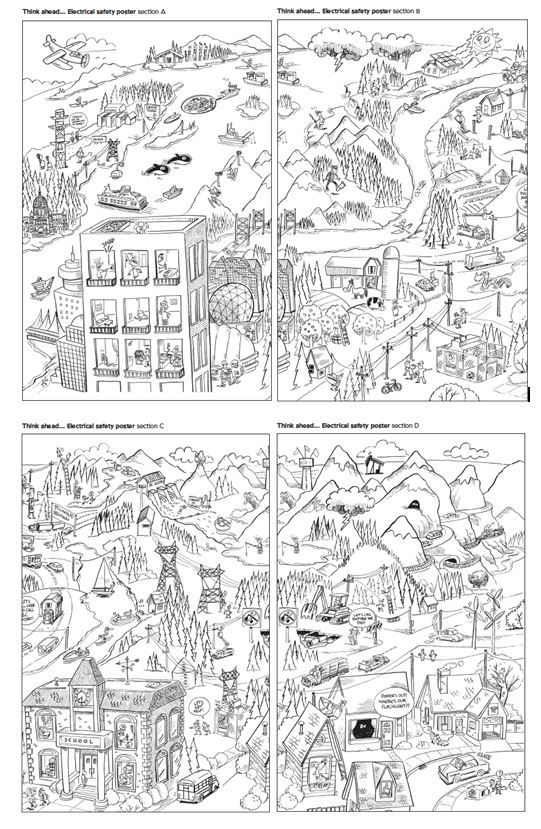Think ahead... Electrical safety
Students identify safety hazards and discuss the think ahead approach to being safe around electricity.

Overview
Where are the electrical safety hazards in real-world situations? Students learn how to think ahead and stay safe around electricity by using posters to find different safety hazards. The safety scenarios are common to most students’ experiences – including rural, urban and indoor and outdoor scenarios.
Instructions
What you'll need
- "Think ahead… electrical safety" poster (1 section per student)
- "Think ahead… electrical safety" worksheet (1 per student)
- Markers and pencil crayons
Explain the “Think ahead” approach
- Ask students what the “Think ahead” approach to electrical safety might be.
- Discuss that the “Think ahead” approach means identifying hazards and coming up with strategies to avoid or respond to unsafe situations at home, at school or in the community.
Form groups
- Hand out one poster section (A, B, C or D) to each student. Have students find a partner with the same section and work together to identify electrical safety hazards.

- Students work together and discuss the hazards, becoming experts on their section of the poster.
Build the posters
- Have students arrange themselves in groups of four, so that each group has an A, B, C, and D section.
- Have the students piece the four posters together to create one large scene.
- Students should see something like the picture below.

- Each student should share the hazards they found on their poster with their group.
- Have each group choose two or more safety hazards and suggest a safe action plan for those situations.
- Show the answer key and ask the students to check that they've identified all the hazards.
Electrical safety discussion
- Review the thinking and decision-making processes common to any situation involving electrical safety:
- What is the possible electrical hazard? Am I in immediate danger?
- What are my options to avoid the hazard?
- What will I do to avoid getting injured?
- Can I find an adult or expert to help me fix the situation?
Show what you know
- Ask the students to complete the “Think ahead… Electrical safety” worksheet to review what they learned.
- Have students begin colouring their posters, beginning with the safety hazards and working their way out to the rest of the poster.
Curriculum Fit
Grade 5 Physical and Health Education
Curricular competencies
Social and community health
- Identify and describe strategies for avoiding and/or responding the potentially unsafe, abusive or exploitive situations
- Describe and apply strategies that promote a safe and caring environment
Grade 6 and 7 Physical and Health Education
Content
- Basic principles for responding to emergencies
Curricular competencies
Social and community health
- Identify and describe strategies for avoiding and/or responding the potentially unsafe, abusive or exploitive situations
Grade 5, 6 and 7 Science
Curricular competencies
Applying and innovating
- Transfer and apply learning to new situations
- Generate and introduce new or refined ideas when problem solving
Communicating
- Communicate ideas, explanations and processes in a variety of ways
Assessments
- Observe students in their groups and assess their ability to:
- Identify hazardous electrical situations
- Communicate ideas and solutions to problems
- Review poster panels and student worksheets and assess student ability to:
- Identify hazardous electrical situations
- Describe a “think ahead” approach to personal safety
- Apply these understandings to their lives
Teaching Notes
The "Think ahead…" approach is one in which students learn to recognize potentially hazardous situations, then decide to act safely based on observations, recalling past experiences and inferring possible hazards.
Electricity awareness
- Electricity will take all paths to reach the ground (not just the quickest path).
- Anything can be a path for high voltage electricity that is carried in power lines above or underground, or within pad mount transformers.
- Electrical contact can cause electric shock, which prevents a person from moving to disconnect from the electricity, and can cause serious internal injuries, burns or electrocution.
- Electrocution is the term used for a death caused by electrical contact.
- Touching anything connected to live electricity can provide a path to ground (e.g. touching a tree or ladder that becomes energized by electricity creates a path to ground through the person). This is called touch potential.
- Electricity moves from high to low concentrations and spreads away from a point of contact on the ground in concentric circles. If a person is standing with one foot on an energized piece of ground and the other foot on a less energized piece of ground, electricity will move through the person. This is called step potential.
- Shuffle or hop away from electrically charged ground (10 metres from point of contact)
- Shuffle with feet close together. The heel of the front foot should not pass the toes of the back foot.
- Water is an excellent conductor of electricity. Water and electricity do not mix.
- High voltage electricity can move through all types of materials including metals, wood, rubber and soil.
- Stay back at least three metres from any above ground power line.
- Stay back at least 10 metres from a downed power line.
- Call 911 if you see a downed or damaged power line.
- Remember these three words: Down. Danger. Dial.
Storms and power outages
- Storms or accidents can cause power lines to fall to the ground. Even if there are no sparks or sounds, the power lines may still be energized. Never go near or touch a fallen power line. Stay back at least 10 metres from any downed line as the ground itself could be energized. Call BC Hydro immediately (1-800-BCHYDRO)
- If your car hits a power pole or a pad mount transformer, or if a power line falls on your car during a storm or accident, do not let anyone get out of the vehicle.
- Stay back at least 10 metres and call 911 immediately.
- If possible, drive the car away at least 10 metres.
- If there is a fire and the car cannot be driven, jump out of the car without touching it.
- Never contact the ground and the vehicle at the same time because your body could provide a connection between the energized car and the ground.
- Shuffle away from the vehicle, keeping both feet close together, or hop if necessary, but hopping is more difficult on unfamiliar terrain.
- Prepare for a power outage. Develop preparedness plan and share it with your family. Make a list of local emergency contact numbers. Purchase or prepare an emergency kit and store it in an easy-to-find location.
- Home generators can be useful during a power outage, but can also be dangerous if they are not used properly. Never use a portable generator indoors, including inside a garage or other enclosed or partially enclosed area – carbon monoxide gas can build up. Carbon monoxide poisoning can lead to death.
- Never plug a portable generator into a regular household electrical outlet. This can cause energy to flow back into the overhead wires and cause a potential hazard to your neighbours and BC Hydro workers.
Recreational areas and dam sites
- Never stand, swim, fish, anchor or tie your boat immediately downstream of a dam. Water levels and flows can change rapidly and take you by surprise, swamping your boat or catching you in an undertow.
- Stay clear of generating facilities including dams, powerhouses and all electrical equipment.
- Respect fenced and gated areas, and observe all safety signs.
- Stay on designated trails and within marked observation areas.
- Stay outside of safety booms and buoys, and away from all dam structures.
- Be alert for audible (e.g. sirens) and visual (e.g. strobe lights) warnings.
- Be alert for changes in water levels.
- Stay off hydroelectric dams or station structures.
Home safety
- Always “Look Up and Look Down!” Be aware of overhead and underground power lines. The overhead wires entering houses and buildings are not insulated, only weather-protected, and therefore cannot protect you from an electric shock. Remember, if you don’t see the power lines above you, they are buried underground.
- You don’t have to touch a power line to be shocked or electrocuted; if you come within three metres of power lines, the energy can arc towards you and take a path to the ground.
- Stay back at least 3 metres from any power line.
- Always call BC One Call at 1-800-474-6886 before digging to avoid underground electricity, gas or service lines.
- When disconnecting an appliance, pull the plug, not the cord as you can damage the cord.
- Don’t overload circuits. This can cause short circuits and possibly a fire. If multiple connections are required, use a properly rated power bar.
- Never use cords or plugs that show any wear or damage. They can cause shocks or fires.
- Never prune or cut down a tree near a power line. Call BC Hydro first (1-800-BCHYDRO) or contact a qualified arborist. If there is a tree touching a line, call BC Hydro.
- Never climb trees that grow near power lines. Electricity can move through the tree or jump towards you if you are within three metres of the line.
- Never climb or play around pad mount transformers (metal boxes with BC Hydro logos that are situated around neighbourhoods and anchored to the ground).
- Keep kites, balloons, remote-controlled airplanes, etc. away from overhead power lines.
- Do not use a two-pronged extension cord outdoors.
- No matter the urge to help or save someone, do not touch someone who is being shocked. Call 911 and wait until BC Hydro can isolate and turn off the power.
Water and electricity
- Keep all electrical cords away from heat and water.
- Never use electrical tools or appliances near water, and never keep water and liquids near appliances.
- Never use an electric lawn mower when it is raining or on wet grass.
- Keep plugged in radios and appliances away from swimming pools or wet surfaces







